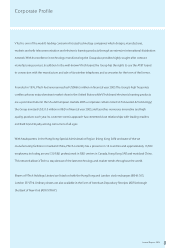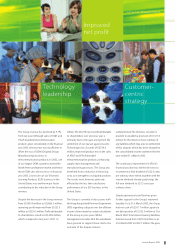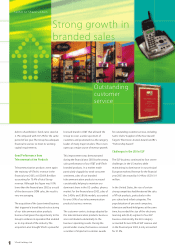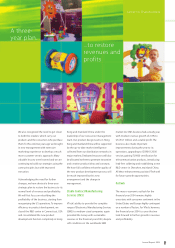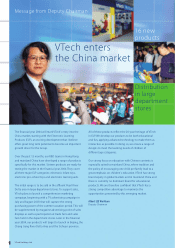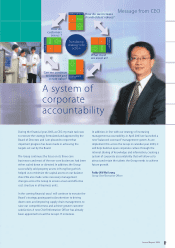Vtech 2003 Annual Report Download - page 13
Download and view the complete annual report
Please find page 13 of the 2003 Vtech annual report below. You can navigate through the pages in the report by either clicking on the pages listed below, or by using the keyword search tool below to find specific information within the annual report.
Annual Report 2003 11
Management Discussion and Analysis
TELECOMMUNICATION PRODUCTS REVENUE BY REGION (US$ million)
North America 569.0
Europe 29.2
Asia Pacific 7.6
Others 4.0
ELECTRONIC LEARNING PRODUCTS REVENUE BY REGION (US$ million)
North America 64.1
Europe 88.0
Asia Pacific 6.3
Others 3.5
US$ million
99 00 01 02 03
R&D EXPENDITURE ON CORE BUSINESSES
31.7 35.2
54.1
31.0
60
50
40
30
20
10
28.9
Geographically, North America remained as
the major market for telecommunication
products, accounting for 93.3% of total
telecommunication products revenue in the
financial year 2003, as compared to 95.0%
in the financial year 2002.
Revenue of the ELP business decreased by
16.4% to US$161.9 million.The ELP business
faced severe challenges in the US market
due to rapid expansion of major
competitors in the pre-school and infant
categories. Competition from personal
computers,TV and hand-held games also
posted a challenge to the ELA category.
Reduction in the shelf space offered by
leading customers put additional pressure
on the business. VTech, however, maintained
its leadership in principal European markets,
which accounted for 54.4% of the total
revenue of the ELP business in the financial
year 2003 as compared to 49.1% in the
financial year 2002. Building on the
innovative ability of our R&D teams in Hong
Kong and mainland China, management
decided to close the R&D centre in
Connecticut, USA and shift the R&D function
to Hong Kong and mainland China under
the leadership of the new management
team that was put in place in late 2002.This
will both lower the operational costs and
improve the Group's ability to develop
products that are better accepted by
consumers.
The CMS business continued to provide a
reliable source of cash flow to the Group,
as the strategy of providing a complete
range of EMS services to medium-sized
companies continued to prove successful.
Despite an overall decline in the EMS market
worldwide, the business recorded modest
revenue growth of 2.0% to US$94.7 million,
while profits remained stable.
GROSS PROFIT Despite the decrease in
revenue, the gross profit of the Group was
comparable to the last financial year.The
gross profit margin for the year improved
from 29.9% to 33.4%.The increase was
mainly attributable to the Group’s strategy
of focusing on higher margin products in
the telecommunication products business.
Enhancement in supply chain management
and manufacturing processes, leveraging
the Group’s volume advantage in
purchasing to reduce materials costs,as well
as improvement in product design to lower
costs also contributed to the improvement
in gross profit margin.
OPERATING PROFIT The operating profit
improved from US$23.0 million to US$59.5
million. Current year’s operating profit
included a non-recurring gain on settlement
of a lawsuit amounted to US$34.0 million.
Excluding such gain, operating profit
increased from US$23.0 million to US$25.5
million. Offsetting the effect of less than
satisfactory performance of ELP business in
the United States, the strong sales of
branded telecommunication products in
both AT&T and VTech brands and the solid
performance of the CMS business
contributed to the increase in the Group’s
operating profit.
In driving product acceptance and sales of
ELP products in the second half of financial
year 2003, the Group launched aggressive
marketing and sales campaigns.This
resulted in a disproportionate increase in
spending on advertising and promotion
dollars, which resulted in a substantial
increase in the Group’s selling expenses
compared to the last financial year.This was
only partly offset by savings from higher
efficiency in logistics and improved supply
chain management, which considerably
lowered the Group’s distribution expenses.
Staff costs for the year ended 31st March
2003 was approximately US$90 million.Total
number of employees as at year-end
decreased from 14,251 to 13,560.
Notwithstanding the decrease in revenue, the
Group maintained the normal level of
investment in R&D, which represented
approximately 3% to 4% of the Group revenue.


